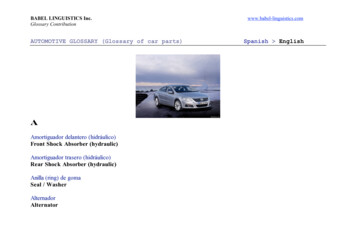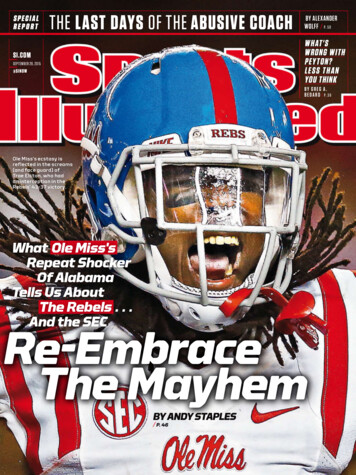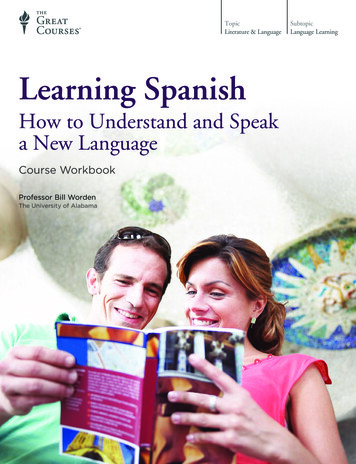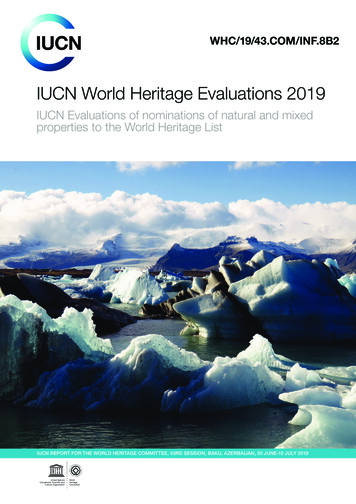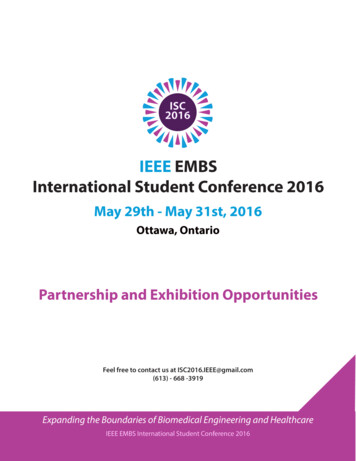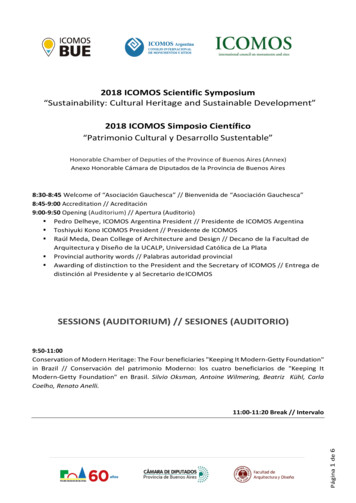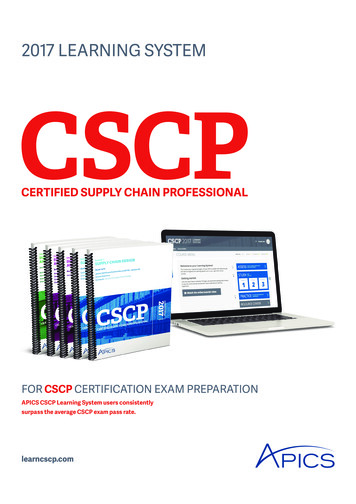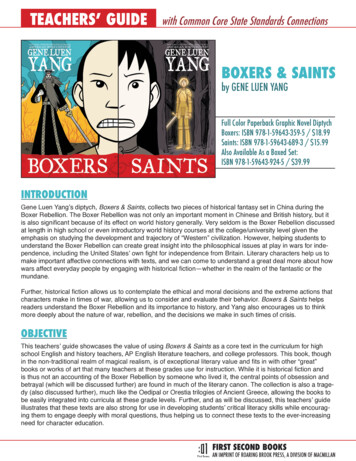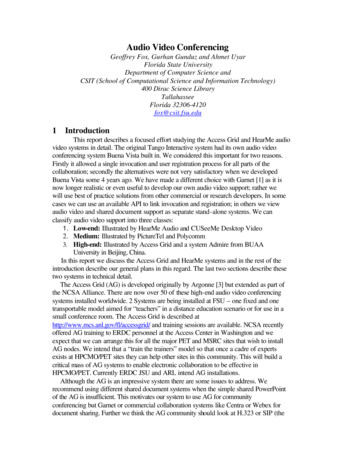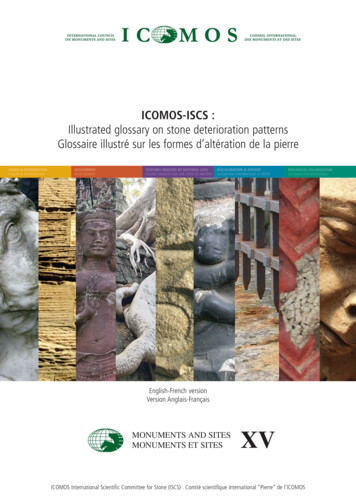
Transcription
ICOMOS-ISCS :Illustrated glossary on stone deterioration patternsGlossaire illustré sur les formes d’altération de la pierreCRACK & DEFORMATIONFISSURE & DÉFORMATIONDETACHMENTDETACHEMENTFEATURES INDUCED BY MATERIAL LOSSFIGURES INDUITES PAR UNE PERTE DE MATIÈREDISCOLORATION & DEPOSITALTÉRATION CHROMATIQUE ET DÉPÔTBIOLOGICAL COLONIZATIONCOLONISATION BIOLOGIQUEEnglish-French versionVersion Anglais-FrançaisMONUMENTS AND SITESMONUMENTS ET SITESXVICOMOS International Scientific Committee for Stone (ISCS) . Comité scientifique international “Pierre” de l’ICOMOS
ICOMOS International Scientific Committee for Stone (ISCS) . Comité scientifique international “Pierre” de l’ICOMOS
ICOMOS-ISCS :Illustrated glossary on stone deterioration patternsGlossaire illustré sur les formes d’altération de la pierreMONUMENTS AND SITESMONUMENTS ET SITESXVRECOMMENDATIONS FOR BEST PRINTING RESULTSRECOMMANDATIONS POUR UN MEILLEUR RENDU À L'IMPRESSIONThis 86 pages glossary is meant to be printed recto-verso in full colours. When the book isopen, each definition should appear on the left page, and the corresponding illustrations onthe right page.Ce glossaire comporte 86 pages. Pour qu'il soit compréhensible, il faut l'imprimer en pleinescouleurs et en recto-verso. Lorsque le livre est ouvert, chaque définition doit figurer sur lapage de gauche, et les illustrations correspondantes sur la page de droite.PURCHASING INFORMATIONPURCHASING ORDERA limited number of the printed version of this publication can be purchased from theICOMOS-International Documentation Centre,Un nombre limité de la version imprimée de cette publication est vendue par le centre dedocumentation d'ICOMOS International :49-51, rue de la fédération 75015 Paris, France - verrier@icomos.org, Fax : 33 1 45 66 06 22 :Postage RateEconomyPriorityICOMOS member20 Euros25 EurosNon member25 Euros30 EurosA découper et retourner à ICOMOS International - 49-51, rue de la fédération - 75015 Paris, FranceName / Prénom : . Date : .Family name / Nom de famille : .Company / Compagnie : .Address / Adresse : .Tel : . Fax : . e-mail : .Payment should be made in Euros by / Merci d'effectuer le paiement en Euros par :Credit Card / Carte bancaire (VIA, Eurocard, Mastercard, American Express)Pay Pal : to verrier@icomos.orgBank transfert to / Virement à :CRÉDIT DU NORDIBAN: FR76 3007 6023 5211 5890 0020 018BIC: NORDFRPPCheque : Only cheques from French Bank accounts are accepted / Cheque : Seuls leschèques établis sur une banque française sont acceptés.
ICOMOS International Scientific Committee for Stone (ISCS) . Comité scientifique international “Pierre” de l’ICOMOS
ICOMOS-ISCS :Illustrated glossary on stone deterioration patternsGlossaire illustré sur les formes d’altération de la pierreMONUMENTS AND SITESMONUMENTS ET SITESXVCONTRIBUTORS /CONTRIBUTIONS(Alphabetical order / Ordre alphabétique)English version / Version AnglaiseTamara Anson Cartwright, Ministry of Culture, Toronto, Canada; Elsa Bourguignon,Conservation scientist, France; Philippe Bromblet, CICRP, Marseille, France; Jo Ann Cassar,Institute for Masonry and Construction Research, Msida, Malta; A. Elena Charola, Universityof Pennsylvania, Philadelphia, USA; Eddy De Witte, KIK-IRPA, Brussels, Belgium; JoseDelgado-Rodrigues, LNEC, Lisbon, Portugal; Vasco Fassina, SPAS-Veneto, Venice, Italy;Bernd Fitzner, RWTH, Aachen, Germany; Laurent Fortier, LRMH, Champs-sur-Marne, France;Christoph Franzen, IDK, Dresden, Germany; José-Maria Garcia de Miguel, ESM UPM,Madrid, Spain; Ewan Hyslop, British Geological Survey, Edinburgh, UK; Marie KlingsporRotstein, Skanska, Stockholm, Sweden; Daniel Kwiatkowski, Skanska, Stockholm, Sweden;Wolfgang E. Krumbein, ICBM, Oldenburg, Germany; Roger-Alexandre Lefèvre, UniversityParis XII, Créteil, France; Ingval Maxwell, Historic Scotland, Edinburgh, UK; AndrewMcMillan, British Geological Survey, Edinburgh, UK; Dagmar Michoinova, NIPCMS, Prague,Czech republic, Tadateru Nishiura, Kokushikan University, Tokyo, Japan; Kyle Normandin,Wiss, Janney Elstner Associates Inc., New York, New York, USA; Andreas Queisser, EPFL,Lausanne, Suisse; Isabelle Pallot-Frossard, LRMH, Champs-sur-Marne, France; VasuPoshyanandana, Office of National Museums Bangkok, Thailand; George W. Scherer,Princeton University, USA; Stefan Simon, Rathgen-Forschungslabor, Staatliche Museen zuBerlin, Germany; Rolf Snethlage, Bayerisches Landesamt für Denkmalpflege, Munich,Germany; Francis Tourneur, Pierres et Marbres de Wallonie, Namur, Belgium; Jean-MarcVallet, CICRP, Marseille, France; Rob Van Hees, TNO, Delft, Netherland; MyrsiniVarti-Matarangas, IGME, Athens, Greece; Véronique Vergès-Belmin, LRMH, Champs-surMarne, France; Tomas Warscheid, MPA, Bremen, Germany; Kati Winterhalter, Architect,Helsinki, Finland; David Young, Heritage consultant, Campbell, Australia.Translation and adaptation into French / Traduction et adaptation en FrançaisP. Bromblet, J.-M. Vallet, V. Vergès-Belmin.Edition / Coordination : V. Vergès-BelminLay out / Maquette : Nadine GuyonISBN : 978-2-918086-00-0EAN : 9782918086000Impression septembre 2008, Ateliers 30 Impression, Champigny/Marne, France
ICOMOS International Scientific Committee for Stone (ISCS) . Comité scientifique international “Pierre” de l’ICOMOS
PREFACEPRÉFACEThe ICOMOS International Scientific Committee forStone (ISCS) is providing a forum for the interchange ofexperience, ideas, and knowledge in the field of stoneconservation. ISCS aims at facilitating the publication,dissemination and presentation of state of the artreviews on pre-identified issues. Simplification anddemystification of scientific information for practitioners are also part of the main goals of the group.Le comité scientifique International de l’ICOMOS (ISCS)constitue un forum d’échanges d’expériences, d’idées etde connaissances dans le domaine de la conservationde la Pierre. L’ISCS a pour but de faciliter la publication,la dissémination et la présentation de revues sur unchoix de problèmes. Il s’attache aussi à simplifier,démystifier l’information scientifique pour les praticiens.In studies on stone deterioration and conservation, terminological confusions lead to major communicationproblems between scientists, conservators and practitioners. In this context, it is of primary importance to setup a common language; if degradation patterns can beshown, named and described, then they can be recognised and compared with similar ones in a more accurateway in further investigations.Dans les études sur la détérioration et la conservationde la pierre, les confusions terminologiques conduisentà des problèmes de communication majeurs entreconservateurs, restaurateurs et scientifiques. Dans cecontexte, l’établissement d’un langage commun est primordial. Si les figures d’altération peuvent être montrées, nommées et décrites, elles peuvent êtres reconnues et comparées de façon exacte avec d’autres dansdes investigations ultérieures. Le glossaire illustré del’ISCS constitue ainsi un outil important pour les discussions interdisciplinaires sur les phénomènes et processus de dégradation. Sa version publiée sur Internet estégalement une excellente collection d’images pour lescours sur la conservation de la pierre.The ISCS glossary constitutes an important tool forscientific discussions on decay phenomena and processes. It is also an excellent basis for tutorials on stonedeterioration. It is based on the careful examination ofpre-existing glossaries of English terms. It does not aimat replacing these glossaries, often set up originally in alanguage other than English, and for most of them doneto a high standard.As President of ICOMOS I would like to congratulate theInternational Scientific Committee for Stone and itsPresident Véronique Verges-Belmin for the results ofyears of research presented in this publication. Stoneconservation is a crucial topic in monument conservation and many of our National Committees all over theworld hope for advice and help from the specialistsfamiliar with traditional and modern methods ofconservation. The Illustrated Glossary on StoneDeterioration Patterns offers a wide range of suggestions and practical advice. Probably, after the EnglishFrench version becomes avaible the Glossary will alsobe translated into other languages. In view of the accelerating decay of our stone monuments worldwide thisis an exemplary contribution which will promote theinternational cooperation so important in this field.Prof. Dr. Michael Petzet, President of ICOMOSLe glossaire ISCS est construit à partir d’un examenattentif de glossaires préexistants en anglais. Il ne prétend pas s’y substituer car ces derniers, pour la plupartoriginellement établis dans d’autres langues que l’anglais, sont pour la plupart très bien faits.En tant que Président de l ICOMOS, j aimerais féliciter lecomité international Pierre et son président VéroniqueVerges-Belmin pour le résultat des années de recherches présenté dans cette publication. La conservationde la pierre est un sujet crucial dans le domaine de laconservation monumentale, et nombreux sont de par lemonde les comités nationaux qui espèrent obtenir aviset aide de la part de spécialistes familiers avec lesméthodes de conservation modernes et traditionnelles.Le Glossaire ISCS offre une large palette de suggestionset avis pratiques. La version franco-anglaise du glossaire est probablement une étape vers des versions dansd autres langues: vu le rythme qu atteint l altération denos monuments en pierre au niveau mondial, ce glossaire constitue une contribution exemplaire qui va promouvoir la coopération internationale si importantedans ce domaine.Prof. Dr. Michael Petzet, Président de l ICOMOSICOMOS International Scientific Committee for Stone (ISCS) . Comité scientifique international “Pierre” de l’ICOMOS1
SUMMARY . SOMMAIREpageBACKGROUND GLOSSARIES . GLOSSAIRES DE REFERENCE 4 GLOSSARY OVERVIEW . APERÇU GÉNÉRAL DU GLOSSAIREGENERAL TERMSTERMES GÉNÉRAUX ALTERATION . ALTÉRATIONCRACK & DEFORMATIONFISSURE & DÉFORMATION CRACK . FISSUREDAMAGE . DÉGRADATIONpage10page6DECAY . DÉGRADATIONpageDEFORMATION . DÉFORMATION12Fracture . FractureStar crack . Fissuration en étoileHair crack . MicrofissureCraquele . CraquellementSplitting . ClivageDETACHMENTDÉTACHEMENT BLISTERING . BOURSOUFLUREpage14pageBURSTING . ECLATEMENT16DELAMINATION . DÉLITAGEpage18Exfoliation . ExfoliationFEATURES INDUCEDBY MATERIAL LOSSFIGURES INDUITES PARUNE PERTE DE MATIÈRE pagepagepageALVEOLIZATION . ALVÉOLISATION 28 EROSION . ÉROSION 30 MECHANICAL DAMAGE . DÉGÂT MÉCANIQUE 32Coving . CreusementDifferential erosion .Erosion différentielleLoss . Perte :of components .de constituantsof matrix . de matriceImpact damage . Trace d’impactCut . IncisionScratch . RayureAbrasion . AbrasionKeying . BûchageRounding .Erosion en bouleRoughening .Augmentation de rugositéDISCOLORATION& DEPOSITALTÉRATION CHROMATIQUEET DÉPÔT CRUST .CROÛTEpage42pageDEPOSIT . 44DÉPÔTBlack crust .Croûte noirepageDISCOLOURATION .46ALTÉRATION CHROMATIQUEpageEFFLORESCENCE . 48EFFLORESCENCEColouration . ColorationpageENCRUSTATION . 50ENCROÛTEMENTConcrétion . ConcrétionBleaching . DécolorationSalt crust .Croûte salineMoist area . Assombrissement dû à l’humiditéStaining . TacheBIOLOGICALCOLONIZATIONCOLONISATIONBIOLOGIQUE BIOLOGICAL COLONIZATION . COLONISATION BIOLOGIQUEINDEX . INDEX2page76page64ALGA . ALGUEpageREFERENCES . RÉFÉRENCES 78ICOMOS International Scientific Committee for Stone (ISCS) . Comité scientifique international “Pierre” de l’ICOMOSpage66
ICOMOS-ISCS :Illustrated glossary on stone deterioration patterns . Glossaire illustré sur les formes d’altération de la pierreDEGRADATION . DÉGRADATIONDETERIORATION . DÉGRADATIONpagepageWEATHERING . ALTÉRATION MÉTÉORIQUEpagepage8DISINTEGRATION . DÉSAGRÉGATION 20 FRAGMENTATION . FRAGMENTATION 22 PEELING . PELAGE 24SCALING . DESQUAMATIONCrumbling . EmiettementSplintering . Fragmentation en esquillesFlaking . EcaillageGranular disintegration . Désagrégation granulaireChipping . EpaufrureContour scaling . Contour scalingpage26Spalling . Desquamation en plaquePowdering, Chalking . Pulvérulence, FarinageSanding . Désagrégation sableuseSugaring . Désagrégation saccharoïdepagepageMICROKARST . MICROKARST 34 MISSING PART . PARTIE MANQUANTE 36PERFORATION . PERFORATIONpage38PITTING . PITTINGpage40Gap . TrouFILM .FILMpagepage52 GLOSSY ASPECT . 54ASPECT LUISANTGRAFFITI .GRAFFITIpage56PATINA .PATINEpage58pagepageSOILING .60 SUBFLORESCENCE . 62ENCRASSEMENTSUBFLORESCENCEIron rich patina .Patine ferrugineuseOxalate patina .Patine d’oxalatesLICHEN . LICHENpage68MOSS . MOUSSEpage70MOULD . MOISISSUREICOMOS International Scientific Committee for Stone (ISCS) . Comité scientifique international “Pierre” de l’ICOMOSpage72pagePLANT . PLANTE743
BACKGROUND GLOSSARIESGLOSSAIRES DE REFERENCEENGLISH / ANGLAISIn 2001, when the group began its compiling task,seven documents, comprising various numbers ofentries were identified as a basis for collecting andcombining useful terms into a generalised glossary.The oldest one is an unpublished list of 21 terms written by A. Arnold, D. Jeannette and K. Zenhder (1980),who performed that task within the framework of theISCS-petrography group activities. This glossary includesan alphabetical list of terms in English, French andGerman, with related definitions in the three languages.The second document is a compilation of 24 Englishterms with related definitions, published by Grimmer(1984) of the U.S. National Park Service.The third document is the Italian Standard Normal 1/88published in 1990 and called "Alterazioni macroscopiche dei materiali lapidei : lessico". Each one of the 27terms in this glossary is illustrated by photographs,usually in two different scales and by a graphic chart tobe used if mapping of deterioration patterns is needed.This glossary, and related definitions have been translated into English by Apy Elena Charola. This author hasalso translated the terms, without their definitions, intoSpanish and Portuguese.The fourth set of documents is a proposal for a terminology of stone decay forms on monuments, written byJose Delgado Rodrigues from LNEC (Lisbon, Portugal). Itcomprises 26 terms, and was largely inspired in internaldocuments produced in the framework of thePetrography Group of the ICOMOS Stone Committeeand published in its newsletter in 1991.This proposal was used as a basis for the publication byLNEC, in 2004, of a glossary with short definitions inPortuguese language, including terms related to stone,masonry and render deterioration (Henriques et al.,2004). Each term is translated into French, Italian andSpanish, and is associated with a graphic chart.The sixth document is a detailed contribution byB. Fitzner, K. Heinrichs & R. Kownatzki (1995), on classification and mapping of weathering forms, which wasupdated in 2002 by Fitzner & Heinrichs. This documentpresents as well definitions of terms which are found ina slightly altered form in the present glossary, as anintroduction into the mapping of stone damages. Thethoroughly illustrated document classifies decay patterns on the basis of type and intensity. A colour andgraphic chart is proposed, in the same way as the onewhich can be found in the Italian Standard Normal1/88.4The seventh document (Franke et al. 1998) is a multiauthored book published as a deliverable of a FP5European Commission research program. The documentis an Atlas and a classification of brick masonry deterioration. It deals both with deterioration of the material(bricks, joint and pointing mortars), and with degradation of the whole masonry. It was developed togetherwith an expert system, of which the acronym is MDDS,which stands for "Masonry Damage DiagnosticSystem". In fact all damage types contained in thedocument are to be found in the expert system (VanHees et al 1995), aiming at helping decision makers todiagnose the origin of deterioration and select appropriate methods and materials for brick masonry restoration.The most recent document has been set up by a groupof experts from Germany (VDI 3798. 1998) VDI standsfor "Verein Deutscher Ingenieure, i.e. Association ofGerman Engineers". This document is quite close to astandard, and it is composed of a list of 14 terms inGerman, with a translation into English, accompaniedby a definition and illustrations. A proposal for graphicrepresentation of the decay patterns is also provided, asin the Italian Standard and in the Fitzner system.Although we did our best to gather all the availableinformation, we have obviously missed a number ofdocuments. One of them is an illustrated glossary of 30terms edited by the “Queen’s University of Belfast”(U.K.). On its website (http://www.qub.ac.uk) one canfind a comprehensive weathering features tutorial,which includes both degradation patterns of monuments and natural outcrops, and also refers to anthropogenic damage.To set up the French version of the glossary, the translators have consulted the background glossaries havingterms and definitions in French, and also the followingdocuments: Paper by Belgian colleagues De Henau &Tourneur (1998/99), book Dicobat, edited by De Viganet al. (1990), and CRISTAL glossary, set up in 1999within the frame of the European project Raphaël.ICOMOS International Scientific Committee for Stone (ISCS) . Comité scientifique international “Pierre” de l’ICOMOS
BACKGROUND GLOSSARIESGLOSSAIRES DE REFERENCEFRENCH / FRANCAISEn 2001, quand le comité Pierre a commencé sa tâchede compilation, sept documents de base furent identifiés. Ceux-ci comprennent un nombre variable d’entrées, qui furent combinées pour constituer des listes determes avec leurs définitions dans plusieurs langues :Anglais, Allemand, Français, Espagnol, Portugais.Le document le plus ancien est une liste non publiée de21 termes, rédigée par A. Arnold, D. Jeannette et K.Zehnder en 1980. Ces auteurs ont accompli cette tâchedans le cadre du groupe Pétrographie de l’ISCS. Le glossaire comporte une liste alphabétique de termes enAnglais, Français et Allemand, avec leurs définitionsdans les trois langues.Le second document est une compilation de 24 termesen Anglais, et leurs définitions, publié en 1984 par AnnGrimmer du U.S. National Park Service.Le troisième document est la norme Italienne 1/88publiée en 1990, et dont le titre est : "Alterazionimacroscopiche dei materiali lapidei : lessico". Chacundes 27 termes est illustré par des photographies généralement à deux échelles, auxquelles est ajoutée unecharte graphique utilisable pour les relevés cartographiques. Ce glossaire a été traduit en Anglais par ApyElena Charola. Cet auteur a également traduit les termes, sans leurs définitions, en Espagnol et Portugais.Le quatrième document est une proposition terminologique écrite en 1991 dans la lettre d’information del’ISCS par José Delgado-Rodrigues du LNEC (Lisbonne,Portugal). Il comporte 26 termes et s’inspire largementdu glossaire ISCS 1980.Cette proposition a elle-même servi de base à unepublication récente du LNEC, qui constitue notre cinquième document de référence (Henriques et al., 2004).Ce document comporte 28 termes traduits en Français,Italien et Espagnol, et se rapportant à la pierre, auxenduits et aux maçonneries. Chaque terme est défini enportugais, et est accompagné d’une charte graphique.Le sixième document est une contribution détaillée deB. Fitzner, K. Heinrichs & R. Kownatzki (1995), sur laclassification et la cartographie de formes d’altération.Ce travail a fait récemment l’objet d’une mise à jour(Fitzner et Heinrich, 2002). Ce document présente aussides définitions de termes en introduction à la cartographie des altérations de la pierre. Certaines définitions seretrouvent dans le glossaire ICOMOS, sous une formelégèrement différente. Le document est parfaitementillustré et muni d’une charte graphique et de couleur, etoù chaque forme d’altération est classée selon son typeet son intensité.Le septième document (Franke et al. 1998) est un livreà auteurs multiples publié comme délivrable d’un programme de recherche financé par la commission européenne dans le cadre de son 5ème programme cadre.Le document est un Atlas et une classification des formes d’altérations de maçonneries en briques. Il concerne aussi bien les altérations des matériaux (briques,mortiers de joint et de rejointoiement) que les maçonneries dans leur ensemble. Il fut développé conjointement avec un programme d’ordinateur doté d’un système expert, dont l’acronyme "MDDS" signifie "MasonryDamage Diagnostic System". En fait tous les types d’altérations que comporte l’atlas sont intégrés dans le système expert (Van Hees et al 1995), qui est conçu pouraider les preneurs de décisions à diagnostiquer l’originedes détériorations et à sélectionner les méthodes lesplus appropriées et les matériaux pour la restaurationsdes maçonneries en briques.Le huitième document a été établi par un groupe d’experts allemands (VDI 3798. 1998). VDI veut dire "VereinDeutscher Ingenieure, i.e. Association des IngénieursAllemands". Ce glossaire est assez proche d’une norme,et est composé d’une liste de 14 termes en Allemand,avec une traduction en Anglais et en français, accompagnée d’une définition et d’illustrations. Une charte graphique est également proposée, comme dans la normeitalienne, le système de Fitzner et le document du LNEC.Le document le plus récent est un glossaire illustréde 30 termes, consultable sur le site web de la"Queen’s University of Belfast", au Royaume Uni(http://www.qub.ac.uk). Il s’agit d’un guide à l’usagedes enseignants, qui comporte à la fois des descriptionsd’altérations de monuments et d’affleurements naturels. Le document décrit également un certain nombrede dégradations anthropiques.Bien que nous ayons fait de notre mieux pour rassembler toutes les informations disponibles, nous avons trèscertainement omis de consulter certains documents,nous nous en excusons auprès des auteurs concernés.Pour élaborer la version française du glossaire, les traducteurs ont consulté, outre les glossaires comportantdes termes en français et l’article de De Henau etTourneur (1998/99), d ’une part l’ouvrage Dicobat, rédigé sous la direction de De Vigan et al. (1990), ainsi quele glossaire CRISTAL mis en place en 1999 dans le cadredu projet Européen Raphaël.ICOMOS International Scientific Committee for Stone (ISCS) . Comité scientifique international “Pierre” de l’ICOMOS5
GLOSSARY OVERVIEWAPERÇU GÉNÉRAL DU GLOSSAIREThe glossary is arranged into 6 familiescomposed of 2 to 11 terms :. General terms,. Crack and deformation,. Detachment,. Features induced by material loss,. Discoloration and deposit. Biological colonizationLe glossaire ISCS est composé de 6 famillescomportant de 2 à 11 termes :. Termes généraux,. Fissure et déformation,. Détachement,. Figures induites par une perte de matière,. Altération chromatique et dépôt. Colonisation biologiqueAs far as possible, the authors have kept withinstrict limits, describing deterioration patterns observable by the naked eye. Only a few families deviate from this general rule, for instance “mechanicaldamage” which includes terms such as ”Impactdamage”, “Cut”, “Scratch”, “Abrasion”, and whichis clearly process and not feature oriented.We have chosen to create a specific family including terms related to surface morphologies, called“Features induced by material loss”. This family isimportant because it contains terms allowing adeterioration pattern to be described even if thereis no active material loss at the time the object isdescribed. For instance a surface showing alveolization may be subjected to active granular disintegration or scaling. If there is no more stone lossfrom the surface, it will still have an alveolar relief,but with no further loss of material, and the surface will have a tendency to soil. The same is applicable to “erosion” and “biological colonization”,because a surface may have eroded first and thenbe colonized by algae, lichen or mosses.The ISCS glossary only contains terms related tostone material as an individual element within abuilt object or sculpture. As a consequence, theterms do not relate to the description of the deterioration of a stone masonry structure as a whole.Dans la mesure du possible, nous avons tenté denous en tenir à une description phénoménologiqueà l’oeil nu des figures d’altération. Cela a étépresque toujours possible sauf pour certains termescomme “Dégât mécanique”, qui regroupe “tracesd’impact”, “rayures”, “figures”, “abrasion” manifestement liées à une cause particulière et évidente.Nous avons également pris le parti de distinguerune famille de termes décrivant plutôt les morphologies superficielles, appelée “Figures induites parune perte de matière”. Cette famille de termes estimportante, car elle permet de décrire des surfacesabîmées, même si le processus d’altération n’estplus actif au moment de l’observation. Par exemple, une surface alvéolisée peut être active, auquelcas sa surface présentera une désagrégation granulaire ou une desquamation, mais elle peut etreaussi inactive, auquel cas elle aura tendance à sesalir car la pierre ne perdra plus de matiere à sonniveau. Il en va de même pour “érosion” et “colonisation biologique”, car une surface qui s’est préalablement érodée peut ultérieurement être colonisée par des végétaux.Le glossaire ISCS ne contient que des termes relatifs a la pierre en tant qu element d un mur, ou entant que sculpture. Il ne comporte donc aucunterme decrivant des pathologies de maçonneries.How to find out a particular term in theglossary ?To find a term, one can search from the summaryon page 2, or go to the index page 76.Comment retrouver la description d’uneforme d’altération dans le glossaire ?On peut se reporter au sommaire page 2, ou bienconsulter l’index des termes page 76.6ICOMOS International Scientific Committee for Stone (ISCS) . Comité scientifique international “Pierre” de l’ICOMOS
GENERAL TERMS . TERMES GÉNÉRAUXALTERATION . ALTÉRATIONDAMAGE . DÉGRADATIONDECAY . DÉGRADATIONDEGRADATION . DÉGRADATIONDETERIORATION . DÉGRADATIONWEATHERING . ALTÉRATION MÉTÉORIQUECRACK &DEFORMATIONFISSURE &DÉFORMATIONDETACHMENTDÉTACHEMENTFEATURES INDUCEDBY MATERIAL LOSSFIGURES INDUITES PARUNE PERTE DE MATIÈREDISCOLORATION& DEPOSITALTÉRATION CHROMATIQUEET ECRACK . FISSUREBLISTERING . BOURSOUFLUREALVEOLIZATION . ALVÉOLISATIONCRUST . CROÛTEBURSTING . ECLATEMENTCoving . CreusementBlack crust . Croûte noireBIOLOGICAL COLONIZATION .COLONISATION BIOLOGIQUEDELAMINATION . DÉLITAGESalt crust . Croûte salineALGA . ALGUEEROSION . ÉROSIONExfoliation . ExfoliationDifferential erosion . Erosion différentielleLoss . Perte :of components . de constituantsof matrix . de matriceRounding . Erosion en bouleRoughening . Augmentation de rugositéFracture . FractureStar crack . Fissuration en étoileHair crack . MicrofissureCraquele . CraquellementSplitting . ClivageDEFORMATION . DÉFORMATIONDISINTEGRATION .DÉSAGRÉGATIONCrumbling . EmiettementGranular disintegration .Désagrégation granulairePowdering, Chalking . Pulvérulence,FarinageSanding . Désagrégation sableuseSugaring . Désagrégation saccharoïdeSplintering . Fragmentation en esquillesChipping . EpaufrureDISCOLOURATION .ALTÉRATION CHROMATIQUEColouration . ColorationBleaching . DécolorationMOULD . MOISISSUREPLANT . PLANTECut . IncisionEFFLORESCENCE . EFFLORESCENCEENCRUSTATION . ENCROÛTEMENTConcretion . ConcrétionScratch . RayureAbrasion . AbrasionKeying . BûchageFILM . FILMGLOSSY ASPECT . ASPECT LUISANTPEELING . PELAGEGRAFFITI . GRAFFITISCALING . DESQUAMATIONMISSING PART .PARTIE MANQUANTEPATINA . PATINEGap . TrouOxalate patina . Patine d’oxalatesPERFORATION . PERFORATIONSOILING . ENCRASSEMENTPITTING . PITTINGSUBFLORESCENCE .SUBFLORESCENCEContour scaling . Desquamation en plaqueMOSS . MOUSSEMoist area . Assombrissement dû à l’humiditéMICROKARST . MICROKARSTFlaking . EcaillageLICHEN . LICHENStaining . TacheMECHANICAL DAMAGE .DÉGÂT MÉCANIQUEImpact damage . Trace d’impactFRAGMENTATION .FRAGMENTATIONDEPOSIT . DÉPÔTICOMOS International Scientific Committee for Stone (ISCS) . Comité scientifique international “Pierre” de l’ICOMOSIron rich patina . Patine ferrugineuse7
GENERAL TERMSTERMES GÉNÉRAUX ALTERATION . ALTÉRATIONDAMAGE . DÉGRADATIONDECAY . DÉGRADATIONALTERATIONModification of the material that does not necessary imply a worsening of its characteristics fromthe point of view of conservation. For instance, areversible coating applied on a stone may beconsidered as an alteration.ALTÉRATIONModification du matériau n’impliquant pas nécessairement une dégradation de ses caractéristiquesdu point de vue de sa conservation. Par exemple,un revêtement réversible appliqué sur une pierrepeut être considéré comme une altération.DAMAGEHuman perception of the loss of value due todecay.Pas d’équivalent proposé en Français. VoirDÉGRADATION.DECAYAny chemical or physical modification of the intrinsic stone properties leading to a loss of value or tothe impairment of use.Pas d’équivalent proposé en Français. VoirDÉGRADATION.DEGRADATIONDecline in condition, quality, or functionalcapacity.DÉGRADATIONToute modification chimique ou physique des propriétés intrinsèques de la pierre, conduisant à uneperte de valeur, de qualité ou à une entrave à sonutilisation.DETERIORATIONProcess of m
Credit Card / Carte bancaire(VIA, Eurocard, Mastercard,American Express) Pay Pal : to verrier@icomos.org Bank transfert to / Virement à : CRÉDIT DU NORD IBAN: FR76 3007 6023 5211 5890 0020 018 . Lausanne, Suisse; Isabelle Pallot-Frossard, LRMH, Champs-sur-Marne, France; Vasu
